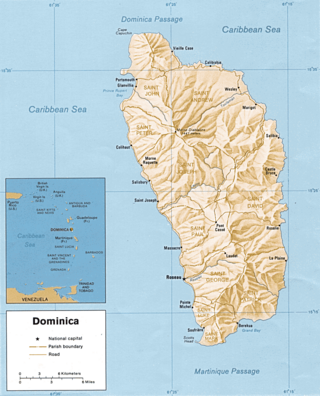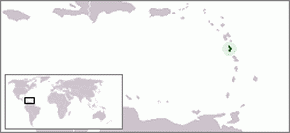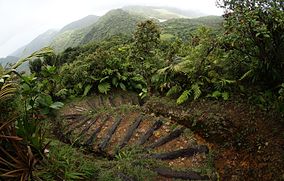
Dominica is an island in the Caribbean Sea, located about halfway between the French islands of Guadeloupe and Martinique. Its coordinates are 15 25 N, 61 20 W. It is known as "The Nature Island of the Caribbean" due to its spectacular, lush, and varied flora and fauna, which is protected by an extensive natural park system. It is the fourth largest island in the Eastern Caribbean with a population of people mainly of African descent.

A fumarole is a vent in the surface of the Earth or other rocky planets from which hot volcanic gases and vapors are emitted, without any accompanying liquids or solids. Fumaroles are characteristic of the late stages of volcanic activity, but fumarole activity can also precede a volcanic eruption and has been used for eruption prediction. Most fumaroles die down within a few days or weeks of the end of an eruption, but a few are persistent, lasting for decades or longer. An area containing fumaroles is known as a fumarole field.

The Boiling Lake is a flooded fumarole located in Morne Trois Pitons National Park, a World Heritage Site on the island of Dominica. The lake, located 6.5 miles (10.5 km) east of Dominica's capital Roseau, is filled with bubbling greyish-blue water that is usually enveloped in a cloud of vapour. The Boiling Lake is approximately 200 to 250 feet across and is the second-largest hot lake in the world after Frying Pan Lake, located in Waimangu Valley near Rotorua, New Zealand.

The Pitons are two mountainous volcanic plugs, volcanic spires, located in Saint Lucia. Petit Piton is 743 m (2,438 ft) high and Gros Piton is 798.25 m (2,618.9 ft) high; they are linked by the Piton Mitan ridge. The Pitons are a World Heritage Site, 2,909 ha in size, and located near the town of Soufrière.

The Carbet Mountains are a massif of volcanic origin on the Caribbean island of Martinique.

Emerald Pool is the name of several locations.

The imperial amazon or Dominican amazon, also known as the sisserou or sisserou parrot, is a parrot found only on the Caribbean island of Dominica. It has been designated as the national bird of Dominica. The species is critically endangered. In 2019, it was estimated there were only about 50 mature individuals left in the wild.
Morne Watt or Watt Mountain is a mountain consisting of one or more stratovolcanoes at the south end of Dominica in the eastern Caribbean Sea. With an elevation of 1,224 m (4,016 ft), it is the third highest mountain in Dominica after Morne Diablotins and Morne Trois Pitons. The mountain is home to the Boiling Lake and Valley of Desolation thermal areas, both of which are the best-known volcanic features in Dominica and major tourist attractions in Morne Trois Pitons National Park.

Laudat is a small village in the interior of Dominica, located between 3 mountains: Morne Watt, Morne Micotrine, and Morne Trois Pitons. With a population of just above 300 people, Laudat is referred to as a "gateway" because it is the sole entry point to many of the islands sights, including the Boiling Lake, Fresh Water Lake, and Titou Gorge. Perched about 1200 feet above sea level Laudat has a cool climate and views of the Caribbean Sea. It is located approximately 20 minutes from the capital, Roseau and is at the end of the road. The road to Laudat used to be a hair-raising ride up the mountains, around blind hairpin turns with sharp drop-offs into the jungle canopy; however, the road has been improved and may be completed by the time of this writing. Laudat has seen many changes over the past years, including the aerial tram taking visitors from the village up into the high mountains--making possible what was previously a journey by foot. Titou Gorge was also altered over the last decade, and is now smaller and more developed. It is still a swimming place, and small waterfalls of hot and cold water stream into the gorge. There are some overnight accommodations available in the village. Laudat receives some of the highest rainfalls in the Caribbean, about 900 cm a year. The air is often misty and cool - a change from the heat of lower-lying areas.

Dominica officially the Commonwealth of Dominica, is an island country in the Caribbean. The capital, Roseau, is located on the western side of the island. It is geographically situated as part of the Windward Islands chain in the Lesser Antilles archipelago in the Caribbean Sea. Dominica's closest neighbours are two constituent territories of the European Union, the overseas departments of France, Guadeloupe to the northwest and Martinique to the south-southeast. Dominica comprises a land area of 750 km2 (290 sq mi), and the highest point is Morne Diablotins, at 1,447 m (4,747 ft) in elevation. Its population was 71,293 at the 2011 census.

The following outline is provided as an overview of and topical guide to Dominica:

The following is an alphabetical list of topics related to the nation of Dominica.
Tourism in Dominica consists mostly of hiking in the rain forest and visiting cruise ships.

Soufrière is a town on the West Coast of Saint Lucia, in the eastern Caribbean Sea. The town and the surrounding district has a population of 7,935. It was colonized by the French and was the original capital of the island.
Morne is an Old-French word for a small mountain. It may refer to:
Morne Nicholls is a mountain in Dominica named after Dominican Sir Henry Alfred Alford Nicholls. The mountain is located on a hiking trail leading to the Valley of Desolation and Boiling Lake.

The Windward Islands moist forests ecoregion covers forested, high-precipitation areas of the volcanic Windward Islands. The forested areas are mostly at higher elevations in the interior of the islands, surrounded by dry forests, dry shrubland, or mangroves on the flat coastal lowlands. Closed forest of this ecoregion cover the majority of the islands. Species diversity is very high.

The Syndicate Nature Trail is a hiking trail in Dominica. It is one of two nature trails in Morne Diablotin National Park. It is located in the foothills of Morne Diablotin, Dominica's tallest mountain, near the edge of the Picard River Gorge.

















